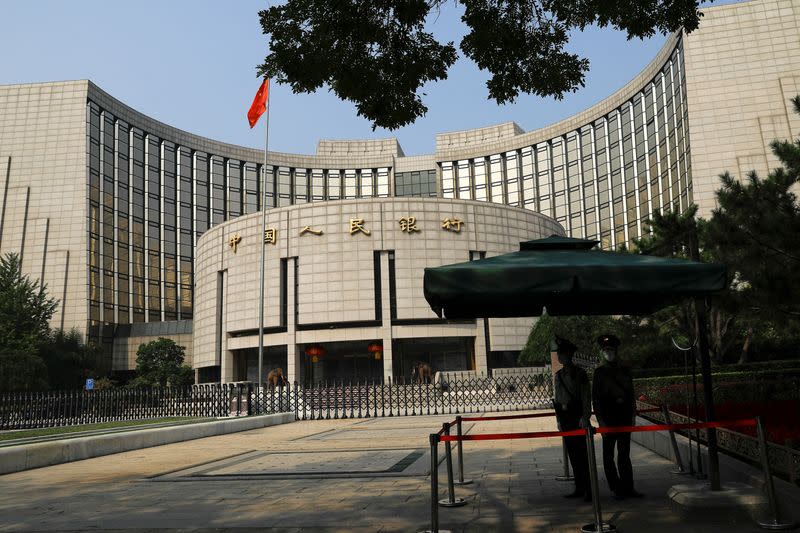China June new bank loans miss forecasts, some money gauges hit record lows

By Kevin Yao and Ellen Zhang
BEIJING (Reuters) -Chinese bank lending jumped less than expected in June while some key money gauges hit fresh record lows, highlighting weak demand in the world's second-largest economy as the country's top leaders prepare to meet to lay out longer-term policy goals.
The money and credit data, released by the People's Bank of China (PBOC) on Friday, added to concerns over the struggling economy as a prolonged property crisis curbs investment and sours consumer confidence.
Banks extended 2.13 trillion yuan ($293.55 billion) in new yuan loans in June, more than double the 950 billion yuan the previous month but less than 3.05 trillion yuan a year earlier.
Analysts polled by Reuters had predicted new yuan loans would jump to 2.25 trillion yuan in June.
"China's new loans and new aggregate financing both came in below estimates, suggesting that the demand for credit remains soft for the time being," said Zhou Hao, chief economist at Guotai Junan International.
"This indicates that further monetary easing is required to help restore sentiment in the property market."
The PBOC does not provide monthly breakdowns but Reuters calculated the June figures based on the bank's January-June data, compared with the Jan-May figure.
The PBOC said new yuan loans totalled 13.27 trillion yuan for the first half of the year.
The property slump and weak expectations for household income growth have hurt consumer confidence.
Still, household loans, mostly mortgages, jumped to 570.9 billion yuan in June from 75.7 billion yuan in May, according to Reuters calculations based on the PBOC data.
China announced sweeping property rescue measures in May, including the removal of the national floor for mortgage interest rates, though analysts say it could take a year or more for the sprawling sector, once a major economic growth driver, to bottom out.
Corporate loans jumped to 1.63 trillion yuan from 740 billion yuan in May.
"Real loan demand remains weak," said a loan officer at a major state-owned bank based in Beijing. "Currently, we're seeing loan requests primarily from state-owned enterprises and sectors where the government encourages lending, like inclusive finance (low income earners and very small companies)," the officer said.
"However, pushing banks to lend more during economic downturns is merely a stopgap measure. Take inclusive loans, for instance. We're issuing them now, but the risk of substantial bad debt in the coming years is significant," he said.
SUPPORTIVE STANCE
Growth in three key money and financing gauges fell to fresh record lows.
Broad M2 money supply rose 6.2% versus a year earlier, below estimates of 6.8% forecast in the Reuters poll and 7.0% in May.
Outstanding yuan loan growth slowed to 8.8% from a year earlier, compared with 9.3% in May. Analysts had expected 9.0%.
Annual growth of outstanding total social financing (TSF), a broad measure of credit and liquidity in the economy, slowed to 8.1% in June from 8.4% in May.
Chinese leaders will seek to shore up economic confidence at a highly anticipated third plenum, a key meeting that starts on Monday, though conflicting requirements such as boosting growth while cutting debt will complicate those plans.
Policy advisers believe China could unveil tax and fiscal changes that would funnel more tax revenues to debt-laden local governments to help ease pressure on their finances.
Central bank Governor Pan Gongsheng pledged last month to stick to a supportive monetary policy stance month and said the bank will use various policy tools including interest rates and reserve requirement ratios to create a good monetary and financial environment for economic development.
Analysts polled by Reuters expect a 10-basis point cut in China's one-year loan prime rate as well as a 25-basis points cut in banks' reserve requirement ratio in the third quarter.
But Pan also said a slowdown in China's credit expansion is natural due to factors such as economic shifts and less lending to the property sector and local government financing vehicles (LGFVs).
With the housing market and consumer demand still weak, the economy has yet to show a meaningful rebound from the pandemic crisis, even though exports have been surprisingly strong.
China is due to publish its second-quarter gross domestic product growth and June activity data on July 15.
(Reporting by Kevin Yao, Ellen Zhang and Ziyi Tang; Editing by Kim Coghill)